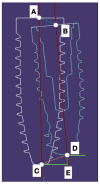Validation of an Intra-Oral Scan Method Versus Cone Beam Computed Tomography Superimposition to Assess the Accuracy between Planned and Achieved Dental Implants: A Randomized In Vitro Study
- PMID: 33542168
- PMCID: PMC7765074
- DOI: 10.3390/ijerph17249358
Validation of an Intra-Oral Scan Method Versus Cone Beam Computed Tomography Superimposition to Assess the Accuracy between Planned and Achieved Dental Implants: A Randomized In Vitro Study
Abstract
Computer aided implantology is the safest way to perform dental implants. The research of high accuracy represents a daily effort. The validated method to assess the accuracy of placed dental implants is the superimposition of a pre-operative and a post-operative cone beam computed tomography (CBCT) with planned and placed implants. This procedure is accountable for a biologic cost for the patient. To investigate alternative procedure for accuracy assessment, fifteen resin casts were printed. For each model, six implants were digitally planned and then placed following three different approaches: (a) template guided free hand, (b) static computer aided implantology (SCAI), and (c) dynamic computer aided implantology (DCAI). The placement accuracy of each implant was performed via two methods: the CBCT comparison described above and a matching between implant positions recovered from the original surgical plan with those obtained with a post-operative intraoral scan (IOS). Statistically significant mean differences between guided groups (SCAI and DCAI) and the free hand group were found at all considered deviations, while no differences resulted between the SCAI and DCAI approaches. Moreover, no mean statistically significant differences were found between CBCT and IOS assessment, confirming the validity of this new method.
Keywords: accuracy; dynamic computer aided implantology; dynamic navigation implantology; intra-oral scanning; static computer aided implantology; superimposition; surgical guides.
Conflict of interest statement
The authors declare no conflict of interest.
Figures













References
-
- Adell R., Eriksson B., Lekholm U., Brånemark P.I., Jemt T. Long-term follow-up study of osseointegrated implants in the treatment of totally edentulous jaws. Int. J. Oral Maxillofac. Implant. 1990;5:347–359. - PubMed
-
- Lang N.P., Pjetursson B.E., Tan K., Brägger U., Egger M., Zwahlen M. A systematic review of the survival and c omplication rates of fixed partial dentures (FPDs) after an observation period of at least 5 years. II. Combined tooth--implant-supported FPDs. Clin. Oral Implant. Res. 2004;15:643–653. doi: 10.1111/j.1600-0501.2004.01118.x. - DOI - PubMed
-
- Wyatt C.C., Pharoah M.J. Imaging techniques and image interpretation for dental implant treatment. Int. J. Prosthodont. 1998;11:442–452. - PubMed
MeSH terms
Substances
LinkOut - more resources
Full Text Sources

